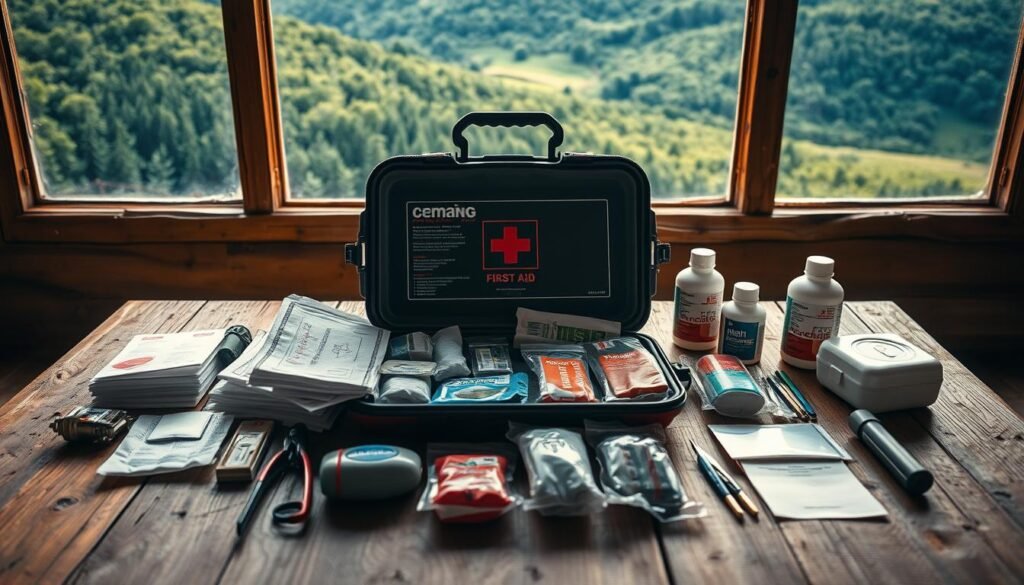When you travel to remote areas, being ready is key. A good health kit can be a lifesaver in emergency situations. It provides emergency medical supplies when you need them most.
Having the right travel health items can save your life. It’s not just about having a kit. It’s about being ready for anything. Whether you’re hiking, camping, or exploring new places, a full health kit protects you from minor injuries and illnesses.
Key Takeaways
- Assemble a health kit with essentials like bandages, antiseptic wipes, and pain relievers.
- Consider the specific needs of your trip, including the environment and activities.
- Include a guide to basic first aid and emergency contact information.
- Check your kit regularly to ensure all items are still usable.
- Keep your first aid kit easily accessible.
Why Remote Travelers Need a Specialized Health Kit
When you go into the wilderness, a specialized health kit can be crucial. It can turn a small problem into a big one. Remote travelers face health challenges that city folks don’t.
Unique Health Challenges in Remote Locations
Traveling to remote places comes with health risks. The biggest issues are not having easy access to doctors and long wait times for help.
Limited Access to Healthcare
In remote spots, doctors and hospitals are far away. This makes it hard to get medical help fast. Travelers must be ready to deal with emergencies by themselves.
Extended Response Times for Emergency Services
Emergency help takes longer in remote areas. This raises the risk of problems getting worse. It’s key to be able to take care of health issues on your own.
Self-Sufficiency as a Safety Measure
Being ready for medical emergencies is vital for safety. A good health kit lets you handle emergencies well. This lowers the chance of serious problems.
Being Prepared for Common Medical Situations
Issues like cuts, allergies, or stomach problems can be managed with the right stuff. Your health kit should have what you need for these common problems. This way, you’re ready for remote travel health challenges.
| Health Challenge | Preparation |
|---|---|
| Limited Healthcare Access | Carry a comprehensive health kit |
| Extended Emergency Response Times | Know basic first aid techniques |
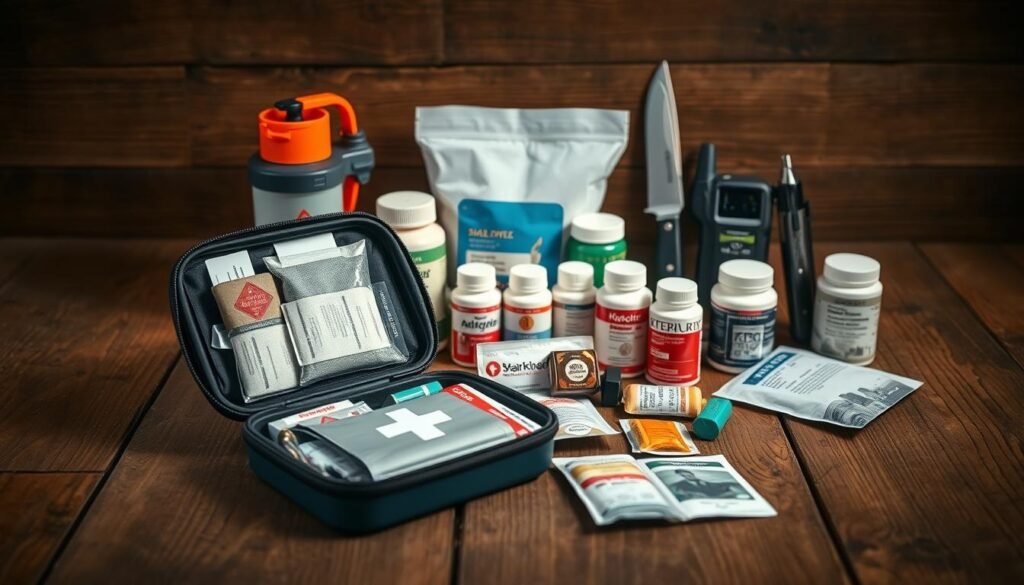
Health experts say, “A traveler who’s ready for emergencies is a traveler who’s safe.” A specialized health kit is more than just a precaution. It’s essential for those traveling to remote places.
Health Kit Essentials for Remote Travelers
Traveling to remote places needs a special health kit. It should have all the must-haves. A well-stocked kit is key to handling medical emergencies well.
Basic First Aid Supplies
First aid supplies are the base of any health kit. They cover wound care and general first aid needs.
Bandages and Wound Dressings
Having various bandages and dressings is key. Adhesive bandages, gauze pads, and rolls help with different wounds. Medical experts say a good dressing prevents infection and aids healing.
Antiseptics and Cleaning Supplies
Antiseptics and cleaning items are crucial for avoiding infection. Antiseptic wipes, hand sanitizer, and soap keep things clean. Cleaning wounds right can lower infection risk a lot.
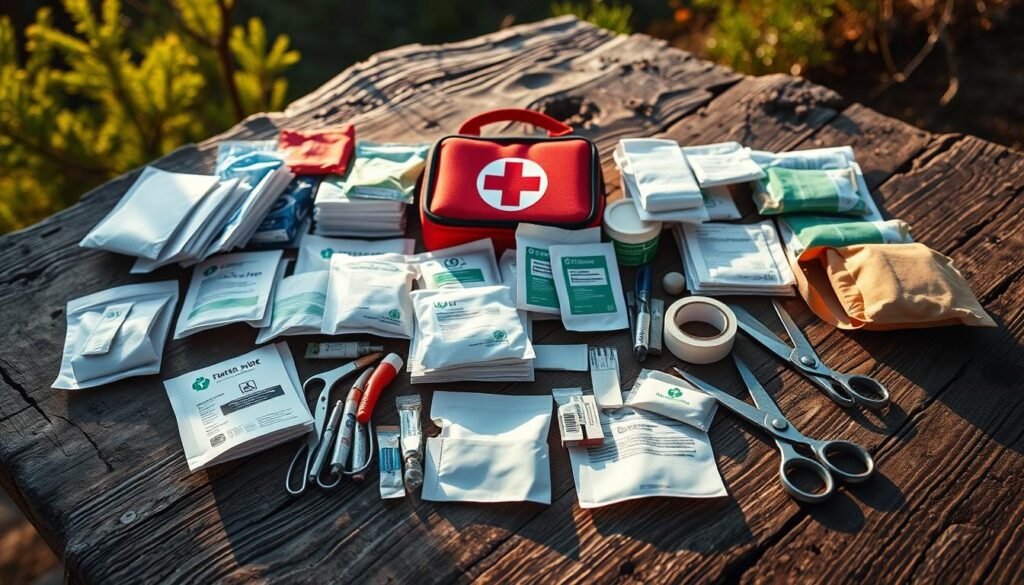
Prescription Medications
For those with certain health issues, prescription medications are a must. It’s important to have enough for the trip and extra for any delays.
Proper Storage and Labeling
Storing and labeling meds right is key. Keep them in a cool, dry spot and label them clearly to avoid mix-ups.
Over-the-Counter Medications
Over-the-counter medications help with common issues. Choosing multi-use meds saves space in your kit.
Multi-Purpose Medications to Save Space
Opt for meds that do more than one thing, like pain relievers that also lower fever. This makes your kit smaller but still packed with what you need.
Medications to Include in Your Travel Health Kit
Traveling to remote areas? A good travel health kit is key. It should have medicines for different health problems.
Pain Relievers and Fever Reducers
For pain and fever, you’ll need pain relievers and fever reducers. Acetaminophen and NSAIDs are good choices.
Acetaminophen vs. NSAIDs
Acetaminophen is best for pain and fever. NSAIDs work better for inflammation. Knowing this helps you pick the right medicine.
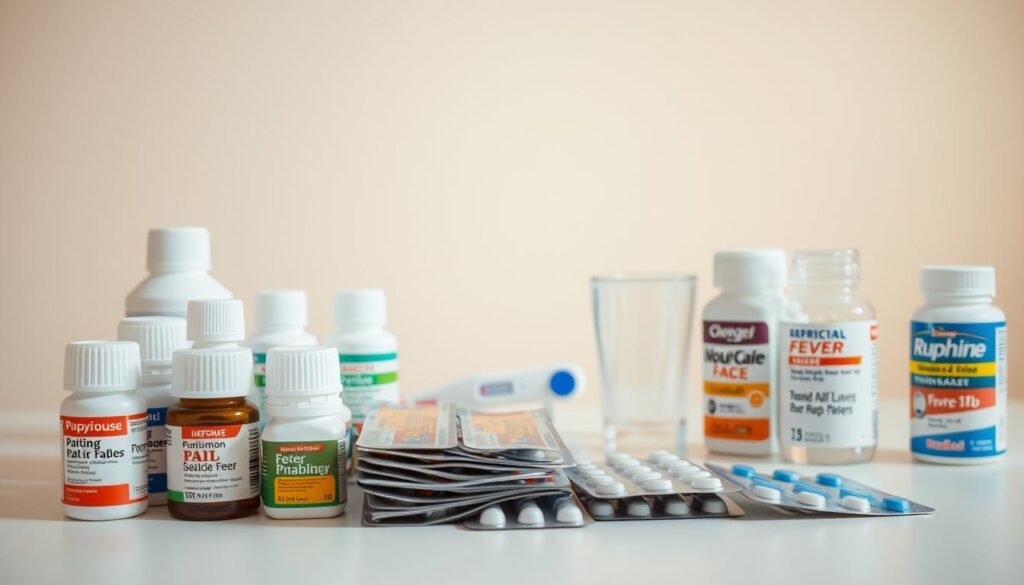
Gastrointestinal Medications
Gastro issues are common while traveling. Antidiarrheals and rehydration solutions can help.
Antidiarrheals and Rehydration Solutions
Antidiarrheals slow down bowel movements. Rehydration solutions replace lost fluids and electrolytes.
| Medication Type | Use | Examples |
|---|---|---|
| Pain Relievers | Manage pain | Acetaminophen, Ibuprofen |
| Antidiarrheals | Slow down bowel movements | Loperamide |
| Rehydration Solutions | Replace lost fluids and electrolytes | Oral Rehydration Salts (ORS) |
Allergy Medications
Allergy meds, like antihistamines and emergency treatments, are crucial for allergic reactions.
Antihistamines and Emergency Allergy Treatments
Antihistamines help with mild allergies. Emergency treatments, like EpiPens, are for severe reactions.
Having these medicines in your kit prepares you for health issues on your trip.
First Aid Supplies for Wilderness Adventures
Wilderness adventures need a special first aid approach. This includes being self-sufficient and ready for anything. The right supplies can be a lifesaver when you’re far from help.
Wound Care Essentials
Proper wound care is key to avoiding infections and helping wounds heal. Make sure your first aid kit has cleaning and disinfecting materials.
Cleaning and Disinfecting Materials
- Antiseptic wipes
- Antibiotic ointment
- Hydrogen peroxide
Bandages and Dressings
You’ll need different bandages and dressings for various injuries.
Variety of Sizes and Types
- Adhesive bandages
- Gauze pads
- Roller gauze
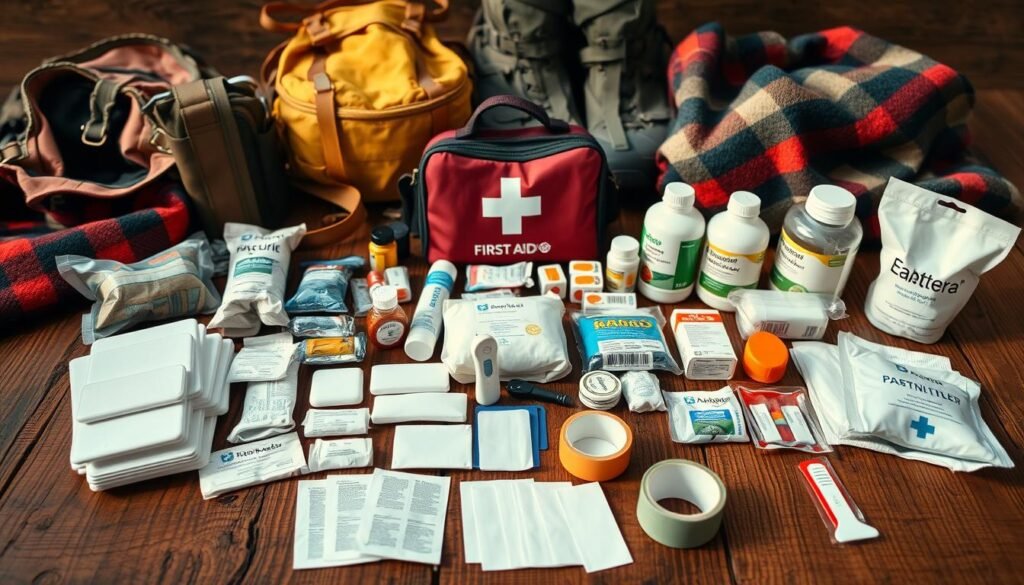
Blister Prevention and Treatment
Blisters can be a big problem on long hikes or treks. Moleskin and special bandages can help prevent and treat them.
Moleskin and Specialized Bandages
- Moleskin sheets
- Blister-specific bandages
Having these essentials in your first aid kit will help you deal with common wilderness injuries.
Emergency Medical Tools and Equipment
When you go into remote areas, having the right emergency medical tools is key. These tools are not just extras; they are crucial for dealing with unexpected medical issues. We will look at the important parts of emergency medical kits, including medical instruments, emergency communication devices, and medical reference materials.
Medical Instruments
Medical instruments are vital for quick care in emergencies. They help travelers do basic medical tasks and interventions.
Tweezers, Scissors, and Thermometers
Tweezers are great for taking out splinters or ticks. Scissors can cut bandages or clothing to help with treatment. A thermometer is key for checking fever, a common sign of many illnesses.
- Tweezers for removing foreign objects
- Scissors for cutting clothing or bandages
- Thermometer for checking body temperature
Emergency Communication Devices
In remote areas, emergency communication devices are key for calling for help. They can be lifesavers when medical help is not nearby.
Satellite Phones and Personal Locator Beacons
Satellite phones let you call emergency services even without cell coverage. Personal Locator Beacons (PLBs) send a distress signal to emergency responders, giving them your location for rescue.
- Satellite phones for emergency calls
- PLBs for sending distress signals
Medical Reference Materials
Having the right medical reference materials is important. They help travelers use their medical kits well. These resources give valuable info on treating different medical conditions.
Wilderness First Aid Guides
Wilderness First Aid Guides give step-by-step instructions for managing medical emergencies in remote areas. They cover topics like wound care and recognizing serious illnesses.
“A good first aid guide can be the difference between a minor issue and a major emergency.” – Wilderness Expert
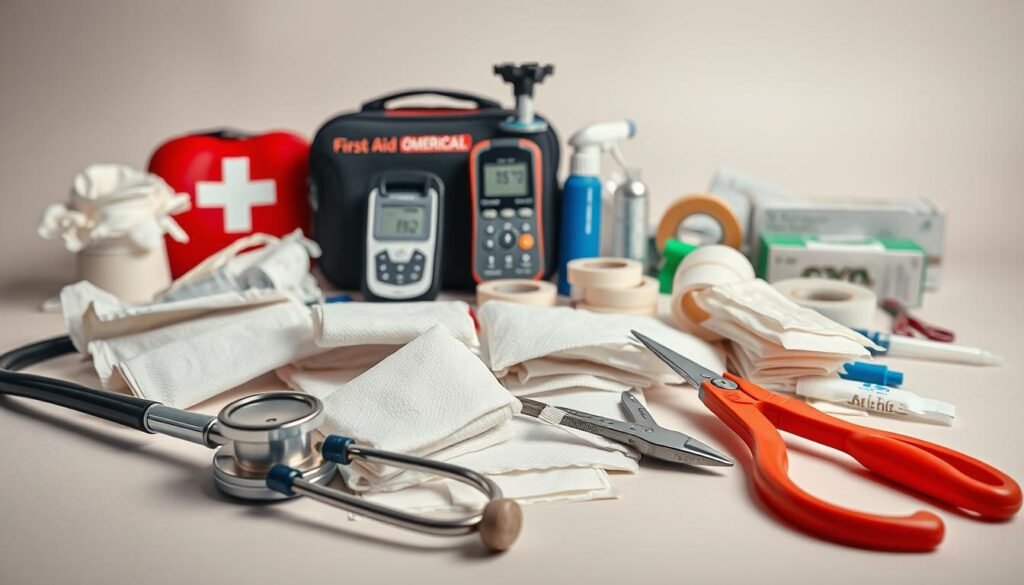
Region-Specific Health Kit Additions
Traveling to remote areas means facing unique health risks. A well-stocked health kit is key to staying safe and healthy.
Tropical Environments
Tropical areas have their own health challenges. Diseases and parasites are common. Malaria prophylaxis is a must.
Malaria Prophylaxis and Mosquito Protection
Make sure your health kit includes malaria prophylaxis. Also, pack mosquito repellents and nets to fight off mosquito-borne illnesses.
High Altitude Destinations
High altitudes can cause altitude sickness, a serious condition. Altitude sickness medications are essential for your health kit.
Altitude Sickness Medications
Medicines like acetazolamide can ease altitude sickness symptoms. Include items to manage discomforts too.
Desert Regions
Deserts pose unique risks like dehydration and heatstroke. Your health kit must be ready for these challenges.
Heat Illness Prevention and Treatment
Staying hydrated is crucial. Add electrolyte supplements and know how to treat heat illness.
| Region | Health Risk | Health Kit Addition |
|---|---|---|
| Tropical | Malaria | Malaria Prophylaxis, Mosquito Repellent |
| High Altitude | Altitude Sickness | Altitude Sickness Medications |
| Desert | Heat Illness | Electrolyte Supplements, Hydration Salts |
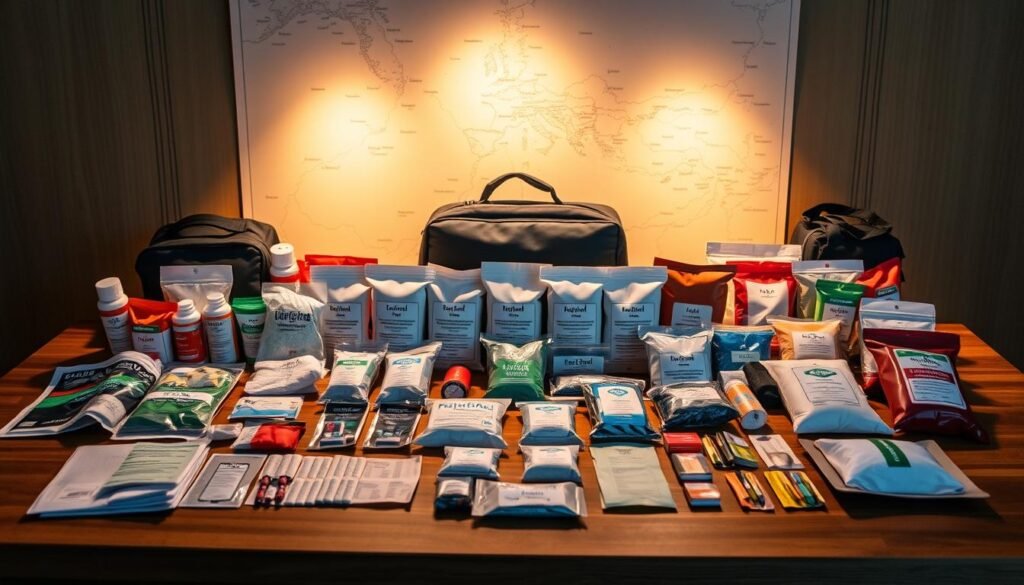
Preventative Health Items for Remote Travel
Traveling to remote areas requires careful planning for health. It’s important to have the right items to prevent illness and injury. When medical help is far away, these items can be lifesavers.
Insect Protection
Insects can carry diseases in many remote places. Repellents with DEET, picaridin, or oil of lemon eucalyptus work well against mosquitoes and other bugs.
Repellents and Bite Treatment
Put repellent on your skin and clothes. For extra protection, treat your clothes with permethrin. If bitten, use anti-itch creams or antihistamines to ease the itch.
Water Purification
Clean drinking water is essential. Water purification methods include filters, tablets, or UV devices.
Filters, Tablets, and UV Devices
Filters can remove dirt and some germs. Tablets or UV light can kill bacteria and viruses. Pick what works best for your trip and environment.
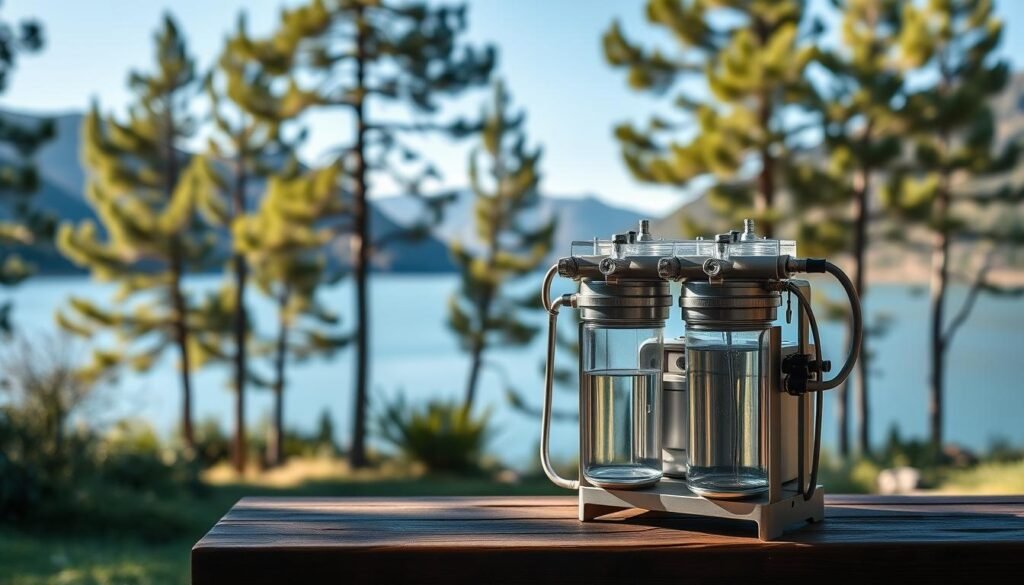
Sun Protection
It’s crucial to protect yourself from the sun, even more so in places like high altitudes or near snow or water.
Sunscreen, Hats, and After-Sun Care
Use sunscreen with a high SPF. Wear clothes and hats that protect you. Don’t forget after-sun lotion to keep your skin moisturized after sun exposure.
Personal Hygiene Essentials for Extended Trips
Keeping clean is key on long trips. The right products can make a big difference. It’s not just about feeling fresh. It’s also about staying healthy, which is important when you’re far from home.
Sanitation Products
Travelers need sanitation products. You’ll want hand sanitizers and biodegradable soaps. These are good for your skin and the planet.
Dental Care Items
Don’t forget about your teeth while traveling. Clean teeth are important for your health.
Feminine Hygiene Products
Women need feminine hygiene products. You can choose between reusable and disposable items. It depends on what you prefer and how long you’ll be away.
Reusable vs. Disposable Options
Reusable items like menstrual cups and cloth pads are good for the environment. They’re also handy for long trips. Disposable items are easier for short trips.
| Product | Reusable | Disposable |
|---|---|---|
| Menstrual Cups | Yes | No |
| Cloth Pads | Yes | No |
| Sanitary Pads | No | Yes |
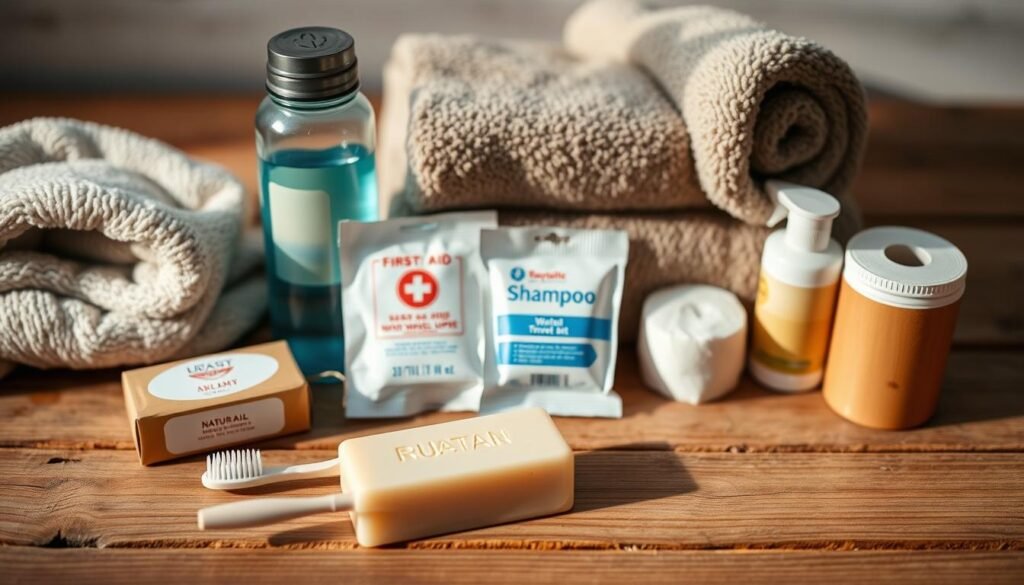
Real-Life Scenarios: When Health Kits Save the Day
Remote travelers have shared many stories. They talk about how health kits saved them from big problems. These stories show how important it is to be ready and how health kits can be lifesavers.
Traveler Stories from Remote Locations
Many adventurers have faced tough situations. But their health kits helped them get through. For example, a hiker in the Rocky Mountains used his kit to treat a bad sprain. This let him safely make his way back.
Lessons Learned from Experience
These stories all point to one thing: being prepared is key. As one traveler said,
“A health kit is not just a precaution; it’s a necessity when you’re far from medical help.”
Common Medical Emergencies and Solutions
In remote places, medical issues can be serious. But with the right health kit, you can handle many problems.
How Proper Preparation Made a Difference
In the Amazon rainforest, a traveler used her kit to treat a snake bite. She gave the right antivenom and kept the patient stable until help came. Proper preparation saved the day, showing how crucial a good health kit is.
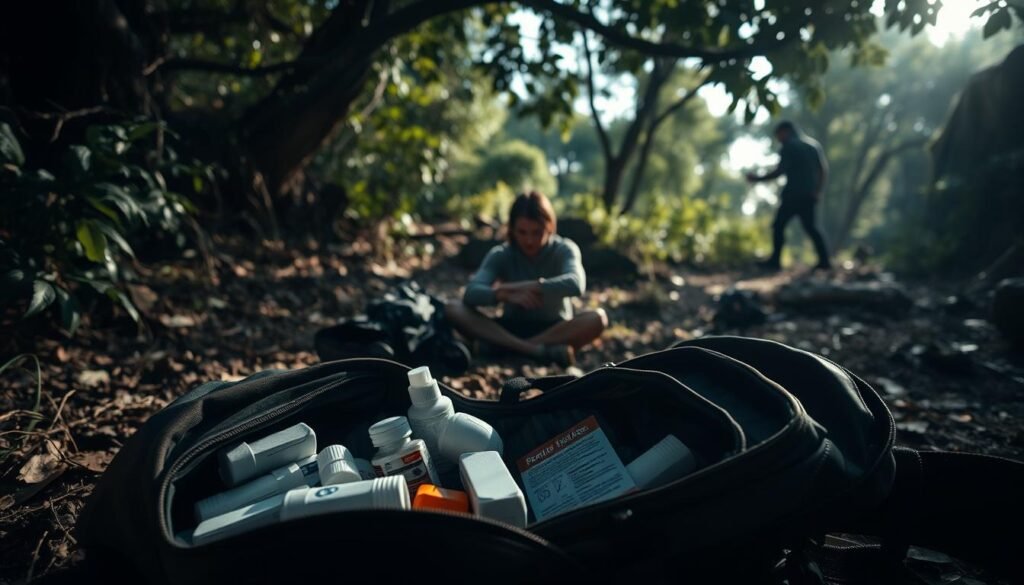
Organizing Your Remote Travel Health Kit
Keeping your health kit organized is key to handling medical emergencies while traveling. A well-organized kit lets you quickly find and use what you need.
Container Options
Choosing the right container is the first step in organizing your health kit. Look for ones that are both tough and easy to get into.
Packing Strategies
Good packing strategies are vital for a well-organized health kit. Sort your supplies and make sure you can get to the ones you use most often easily.
Weight and Space Considerations
When packing your health kit, balance being prepared with practical considerations. Think about the weight and space it takes up.
Balancing Preparedness with Practicality
Consider the weight and bulk of your health kit. Focus on the most important items. Make sure your container is not too heavy or big to carry.
Pre-Trip Medical Preparations
Getting ready for your trip is key to staying healthy in remote places. Being medically prepared can save your life in an emergency.
Vaccinations and Prophylactic Medications
Vaccines and medicines are essential for your trip. What you need depends on where you’re going.
Destination-Specific Requirements
Every place has its own health risks. For example, some tropical areas need shots for yellow fever or malaria prevention.
Medical Check-ups
See a doctor before you leave. They can spot health problems that travel might make worse.
Specialized Consultations for Adventure Travel
If you’re into adventure travel, see a specialist. They can give advice based on your trip and health.
Health Insurance and Documentation
Make sure you have health insurance that works abroad. Check if it includes evacuation insurance.
International Coverage and Evacuation Insurance
Evacuation insurance is vital for traveling far away. It pays for emergency medical flights, which can be very expensive.
- Check your policy: Make sure your health insurance covers you overseas.
- Consider additional coverage: If your policy doesn’t have evacuation insurance, think about getting it.
- Keep documents handy: Have all your insurance papers and emergency contacts ready.
Conclusion
A well-prepared health kit is key for remote travelers. It should include basic first aid, prescription meds, and emergency tools. This ensures a safe and healthy trip.
Traveling to remote areas comes with health risks. But, with the right remote travel health kit, you can face these challenges head-on. You’ll be ready for emergencies.
In conclusion, preparing a detailed health kit is vital. Don’t forget to get your vaccinations and medical checks before you go. This will greatly enhance your travel experience. Stay safe and enjoy your journey.

